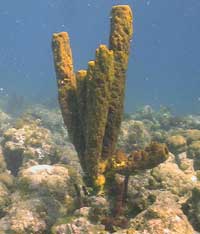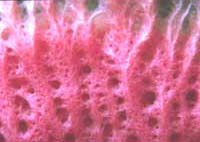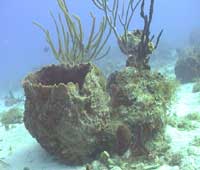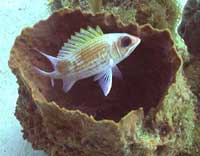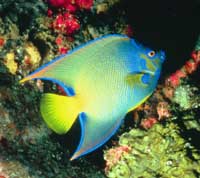 |
|||||||||||||||||||
We are back at Alice's Backside, again. This was our dive site from Day 4. We asked Cori to bring us back here because we remember seeing some neat sponges the last time we dove here. We want to find some sponges to tell you about their mysterious lives. We enter the water and don't have to look far to see different kinds of sponges. We don't need to cruise around the reef on our DVs to find sponges. Any time we are in the water there are sponges all around us. You have been seeing sponges every day of our expedition in every one of our pictures of reefs or wrecks underwater. (In fact, sponges live in all the earth's seas and oceans!) As we cruise over the reef we find a yellow tube sponge with six tubes all connected together. It is about 2 feet tall. Sponges are a common part of the coral reef environment. Sponges can be both helpful and damaging to the corals. Some sponges grow on the undersides of corals and help hold pieces of corals together like glue. Other sponges can damage the coral. These sponges have an acid that eats into the corals. These sponges bore into the corals and can cause them to break apart. The sponges here don't look like Sponge Bob Square Pants. They also don't look like the square sponges you have at home in your kitchen. The sponges underwater come in all colors and may look like baskets, barrels, vases, tubes, balls, fingers, ropes or even look like colorful paint splashed on a rock. Sponges are animals, but unlike any other animals on the reef. Sponges are the simplest of all multicellular animals. Sponges have no feet, eyes, ears, nose, mouth. Sponges have no nervous system, not digestive system, and no circulatory system. Sponges don't even show any reaction to being touched! Sponges are really an underwater version of a vacuum cleaner. Each sponge contains special cells with tiny hairs (flagella). These flagella move back and forth and cause seawater to be sucked into the sponge through thousands of tiny holes on the surface of the sponge. (Sponges have lots of holes like a kitchen sponge. Sponges are also squishy like a kitchen sponge, too.) As the seawater goes through the tiny holes the plankton is sifted out. (The plankton becomes the sponge's dinner!) The sifted seawater is then squirted out through one or more large holes in the sponge like smoke coming out of a chimney. (The seawater is clear so you can't see it coming out.) Because sponges can't run away or hide, they have other ways to protect themselves from being eaten. The fire sponge causes itching and burning if touched. The body of a sponge is made of tiny needles (spicules) that look and feel like slivers of glass! Sponges also taste really bad. Eating a sponge would be like eating a bunch of bad tasting fiberglass insulation (Insulation is the stuff that is crammed between the walls of your house). The only animals that eat these slivery, bad tasting sponges are angelfish and hawksbill sea turtles, like the one we saw eating a sponge yesterday. Because almost no one eats sponges small animals will use sponges as places to hide. They know the no one is going to try to eat into the sponge to get them. As we pass over a big (2 feet tall) basket sponge we see an animal hiding inside. It is a squirrelfish (about 8 inches long)! We have had fun looking at sponges today and now it is time to turn our DVs back to the boat. On our way back to the boat we see a splash of color under some coral. It is not sponge...It is one of the only animals that eats sponges -- an angelfish! It is not just any angelfish. It is the prettiest of all the angelfishes -- the queen angelfish! It's funny that one of the prettiest fishes on the reef eats one of the nastiest things on the reef -- sponge! Tomorrow join us as we fly away to explore the most unusual and dangerous island in all of the Virgin Islands, Anegada Island! Best Fishes, . |
TODAY'S DATA Alice's Backside, Ginger Island Position: 18º 23' N / 64º 29' W
These yellow tube sponges are about 2 feet tall. At the bottom of the tube sponges look for some red finger sponge.
Looking closely at this pink fluorescent tube sponge you can see it has lots of holes.
We found this big basket sponge (about 2 feet tall) that is bigger than the small patch of reef it is growing on. Notice the red finger sponge sticking up on the right side.
We discovered this squirrelfish (about 8 inches long) hiding in the basket sponge. The most beautiful fish on the reef, the queen angelfish (about 10 inches long), eats the nastiest food on the reef -- sponge! (Notice the red and yellow sponges on the wall behind the angelfish.)
|
||||||||||||||||||
home | basecamp | archives | library | other expeditions | kids' page | contact us © 2002, The Ocean Adventure All rights reserved. |
